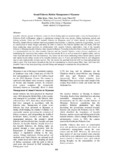| dc.contributor.author | Hattori, Akihisa | |
| dc.contributor.author | Shibuno, Takuro | |
| dc.date.accessioned | 2016-03-11T13:47:37Z | |
| dc.date.available | 2016-03-11T13:47:37Z | |
| dc.date.issued | 2015 | |
| dc.identifier.citation | Hattori, A., & Shibuno, T. (2015). Total volume of 3D small patch reefs reflected in aerial photographs can predict total species richness of coral reef damselfish assemblages on a shallow back reef. Ecological Research, 30(4), 675-682. | en |
| dc.identifier.issn | 0912-3814 | |
| dc.identifier.uri | http://hdl.handle.net/10862/2949 | |
| dc.description.abstract | Because fish have a high dispersal ability, an understanding coral reef fish metacommunity structure is vital for effective conservation. Coral reefs provide patchy habitat of various sizes and scales. We examined the species–area relationship (SAR) of damselfish (Pomacentridae) assemblages over 81 environmentally homogenous patch reefs ranging 0.07–45.4 m2 with low coral cover. Patch reefs were located in the shallow back reef (<2.5 m deep) off Ishigaki Island, Japan. Reef area was measured by performing image analysis of enlarged sections of a high-resolution (>1/2500) color aerial photograph used as a fine-scale seascape map. To assess the effects of three-dimensional meso-scale rugosity on species richness, we assumed that all reefs had a cylindrical shape and examined species by volume (area × height) relationships (SVR). Patch reef volume was a better determinant of species richness than area, and the regression functions of SVR provided better estimates of patch reef species richness. Neither the observed SVRs nor SARs, however, could be explained by a random placement model alone. Our results suggest that several small reefs are likely to have higher species richness than a single large reef of equivalent area in the shallow back reef where large patch reefs are flat. Thus, total patch reef volume (area × height) better reflects meso-scale rugosity and is a useful indicator of total species richness relative to the total amount of essential habitat in shallow back reefs. | en |
| dc.description.sponsorship | This work was supported in part by Grants-in-Aid for Science Research from the Japan Ministry of Education, Culture, Sports, Science and Technology (nos. 23570022, 20570020, 15K07218). | en |
| dc.language.iso | en | en |
| dc.publisher | Springer Verlag | en |
| dc.rights.uri | http://creativecommons.org/licenses/by/4.0/ | |
| dc.subject | Pomacentridae | en |
| dc.subject | Japan | en |
| dc.title | Total volume of 3D small patch reefs reflected in aerial photographs can predict total species richness of coral reef damselfish assemblages on a shallow back reef | en |
| dc.type | Article | en |
| dc.citation.volume | 30 | |
| dc.citation.issue | 4 | |
| dc.citation.spage | 675 | |
| dc.citation.epage | 682 | |
| dc.citation.journalTitle | Ecological Research | en |
| dc.subject.asfa | aerial photographs | en |
| dc.subject.asfa | coral reefs | en |
| dc.subject.asfa | nature conservation | en |
| dc.subject.asfa | environmental factors | en |
| dc.subject.asfa | species richness | en |
| dc.subject.asfa | reef fishes | en |
| dc.subject.asfa | islands | en |
| dc.subject.asfa | scales | en |
| dc.subject.asfa | image processing | en |
| dc.subject.asfa | habitats | en |
| dc.subject.asfa | models | en |
| dc.subject.asfa | color | en |
| dc.subject.asfa | severe acute respiratory syndrome | en |
| dc.subject.asfa | fish | en |
| dc.identifier.essn | 1440-1703 | |
| dc.identifier.doi | 10.1007/s11284-015-1268-0 | |




